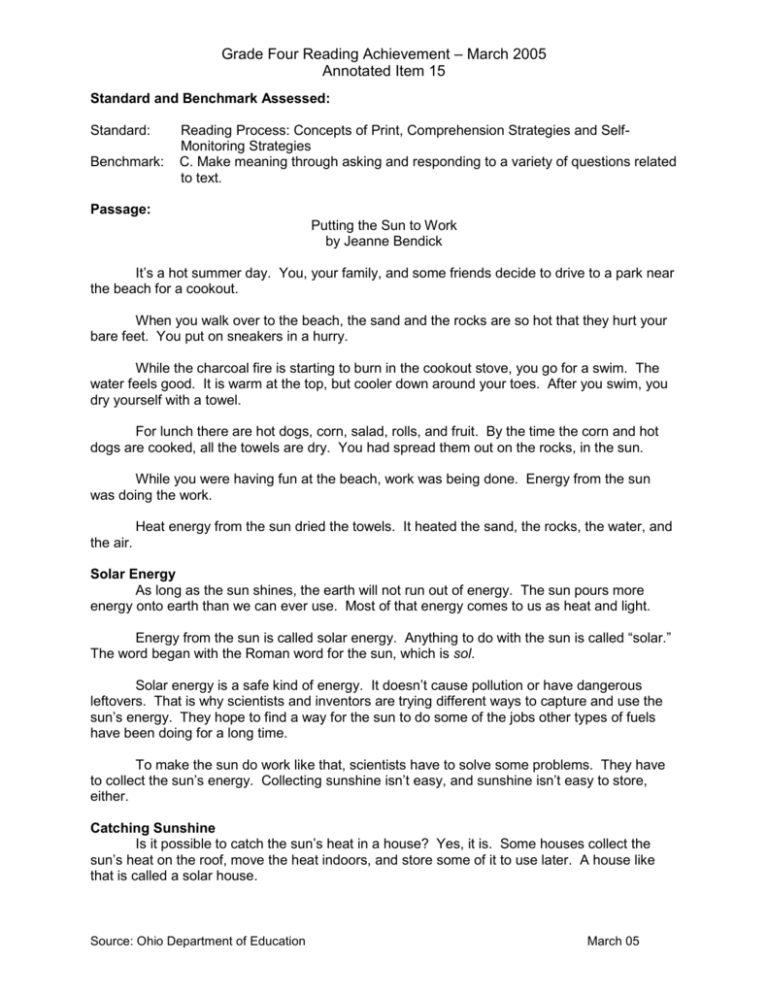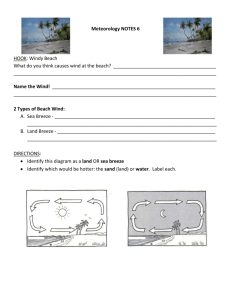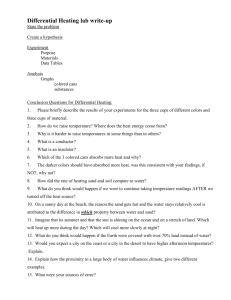Standard and Benchmark Assessed - ODE IMS
advertisement

Grade Four Reading Achievement – March 2005 Annotated Item 15 Standard and Benchmark Assessed: Standard: Benchmark: Reading Process: Concepts of Print, Comprehension Strategies and SelfMonitoring Strategies C. Make meaning through asking and responding to a variety of questions related to text. Passage: Putting the Sun to Work by Jeanne Bendick It’s a hot summer day. You, your family, and some friends decide to drive to a park near the beach for a cookout. When you walk over to the beach, the sand and the rocks are so hot that they hurt your bare feet. You put on sneakers in a hurry. While the charcoal fire is starting to burn in the cookout stove, you go for a swim. The water feels good. It is warm at the top, but cooler down around your toes. After you swim, you dry yourself with a towel. For lunch there are hot dogs, corn, salad, rolls, and fruit. By the time the corn and hot dogs are cooked, all the towels are dry. You had spread them out on the rocks, in the sun. While you were having fun at the beach, work was being done. Energy from the sun was doing the work. Heat energy from the sun dried the towels. It heated the sand, the rocks, the water, and the air. Solar Energy As long as the sun shines, the earth will not run out of energy. The sun pours more energy onto earth than we can ever use. Most of that energy comes to us as heat and light. Energy from the sun is called solar energy. Anything to do with the sun is called “solar.” The word began with the Roman word for the sun, which is sol. Solar energy is a safe kind of energy. It doesn’t cause pollution or have dangerous leftovers. That is why scientists and inventors are trying different ways to capture and use the sun’s energy. They hope to find a way for the sun to do some of the jobs other types of fuels have been doing for a long time. To make the sun do work like that, scientists have to solve some problems. They have to collect the sun’s energy. Collecting sunshine isn’t easy, and sunshine isn’t easy to store, either. Catching Sunshine Is it possible to catch the sun’s heat in a house? Yes, it is. Some houses collect the sun’s heat on the roof, move the heat indoors, and store some of it to use later. A house like that is called a solar house. Source: Ohio Department of Education March 05 Grade Four Reading Achievement – March 2005 Annotated Item 15 People who build solar houses have learned how to do those things by noticing how the earth itself uses solar energy. Remember the beach we talked about earlier? Remember the hot sand and the hot rocks? Some materials take in heat energy from the sun and hold it. These materials absorb the heat. Sand and rocks do this. So do some other solid materials, such as metal. Water absorbs the sun’s heat, too. Storing Heat The longer it takes something to heat up, the longer that thing holds the heat. Materials that heat up fast also cool off fast. If you were to go back to the beach in the evening after sunset, the sand and the rocks, which heated up fast, would be cool. The water, which heated up slowly, would still be warm. Heat always moves from a warmer place or thing to a cooler one. Remember when the hot sand on the beach burned your feet? Heat from the sand was moving into your cooler feet! Once you understand how heat moves into things, through things, and out of things, it is easy to see how a solar house works. Keeping Heat in One Place Once the house is warm, what keeps the heat from moving out of the warm house into the cool outside air? Remember the sneakers you put on when the hot sand was burning your feet? They kept the heat from moving from the sand into your feet. The sneakers were insulation. Insulation is any material that keeps heat (or other kinds of energy) from moving from place to place. Insulation in a house keeps heat from moving out of the house in the winter. It also keeps heat from moving into the house in the summer. It does not take a lot of heat to make a house comfortable. Solar energy can do that job in many areas of the world. Multiple Choice Question: 15. What helps keep a house warm in the winter and cool in the summer? A. B. C. D. absorption heat air-conditioning insulation Commentary: This multiple choice question asks students to identify the material or action that keeps a house warm in winter and cool in summer. Answer choice A is incorrect. There are materials that absorb heat, but this would negatively impact keeping a house warm, not help it.. Answer choice B is incorrect. Heat does not keep a house cool in the summer. Answer choice C is incorrect. Air-conditioning is forced air temperature unrelated to solar energy. It does not keep a house Source: Ohio Department of Education March 05 Grade Four Reading Achievement – March 2005 Annotated Item 15 warm in the winter. Answer choice D is correct. Insulation is any material that keeps heat from moving from place to place. Performance Data: The percent of public school students selecting answer choice D for question 15 on the March 2005 Grade 4 Reading Achievement Test was 58%. Keyword: Questions Linked Passage: Putting the Sun to Work Source: Ohio Department of Education March 05




